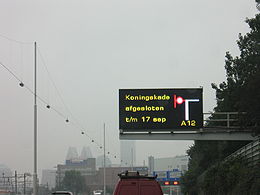Traffic management
Traffic management is the direction, control, and supervision of all functions incident to the procurement and use of freight and passenger transportation services[1]. Traffic management measures include for example lane closure or opening (e.g. HOV lanes, peak lanes), intersection control, ramp metering, dynamic speed limits, etc. In relation to security issues, you can think of re-routing, route closure, traffic information provision, reverse laning, etc. Traffic management is normally performed by traffic management centres.
Contents
Congestion
One of the main issues for traffic management is congestion. Proper traffic management can prevent congestion or reduce the consequences of congestion by for example rerouting of the other traffic. Congestion occurs when the traffic demand exceeds the road capacity. This can occur when the traffic infrastructure capacity is not sufficient to handle normal (peak) traffic volumes (usually at bottlenecks, such as tunnels, bridges, lanedrops, onramps, weaving sections etc.), when the capacity is reduced by e.g. traffic incidents, road works or weather (e.g. rain, snow) or when the demand is higher than usual, e.g. in case of large events or evacuations. Solutions are therefore either reducing the traffic demand or increasing the road capacity.
Congestion has negative consequences for safety and security, because accident risk is higher in or near congestion (e.g. approaching the tail of a traffic jam causes a relatively higher accident risk) and travel times to certain locations will be longer. Ambulances will have difficulty to arrive at an emergency location due to the longer travel times and due to the other traffic blocking the access to the incident. This can be handled with incident management. It is also a security issue, since the police may also be hampered by congestion to reach security relevant locations.
Traffic monitoring
In order to perform effective traffic management, it is necessary to determine if there are disruptions or incidents on the network. This is done with some form of traffic monitoring. Examples of traffic monitoring are loop detectors to count and measure speed of vehicles, radar, bluetooth, counting cameras, license plate recognition or cameras with a normal (video) image to be judged by people in the traffic management centre.
It is a prerequisite for the application of ITS, that monitoring systems ensure the real-time data collection and processing. Reliable data is essential for correct information to influence traffic and drivers (or potential drivers) [2].
Incident management
Use traffic management in order to safely and efficiently clear traffic incidents to minimize traffic delays and help injured people as soon as possible. Emergency services should reach the incident location and remove the blockage on the road as soon as possible.
Incident management is defined as the systematic, planned, and coordinated use of human, institutional, mechanical, and technical resources to reduce the duration and impact of incidents, and improve the safety of motorists, crash victims, and incident responders [3].
Evacuation management
Evacuation management is a special form of traffic management and incident management for the situation that large groups of people need to be evacuated outside a certain area. Depending on the disaster type, there is more or less time available. General goal is to get all people out in as little time as possible. General traffic management measures, such as reverse laning, routing, departure time control can be applied for this. The total evacuation time is dependent of the capacity of the exit roads out of the area and the number of people/vehicles that need to get out. Weak points that limit the outgoing capacity are for example bridges.
Apart from the traffic process of personal vehicles, also public transport or dedicated buses can be used to evacuate people that e.g. don't have a vehicle available.
Special issues in case of evacuations are the evacuation of people from large buildings, vulnerable people such as people in the hospital, and access to critical infrastructures such as the road infrastructure, communication infrastructures and electricity. In case there is no electricity, most traffic management measures do not work anymore.
Dynamic traffic management
Dynamic traffic management has the objective to improve traffic safety and the utilization of the transport infrastructure. Examples of Dynamic Traffic Management Measures are:
Dynamic Speed Limits
Speed limits that may vary over time and take account the real time traffic, road and weather conditions. Dynamic speed limits can be shown to the drivers with a lane signalling system.
Ramp metering
Ramp metering is the use of traffic signals at freeway on-ramps to manage the rate of automobiles entering the freeway. Ramp metering systems have proved to be successful in decreasing traffic and improving driver safety [4].
Dynamic Route Information Panel (DRIP)
One of the dynamic traffic management measures is providing information by means of variable message signs, in The Netherlands called DRIP (elsewhere in the world known as Variable Message Sign or VMS). The information on a DRIP should enable motorists to make a better route choice, based upon the current traffic situation.
Dynamic road marking
Dynamic road marking can be used to actively adapt the road layout in response to varying traffic conditions and therefore have the potential to increase road capacity, thus reducing congestion [5].
Road works management
Using traffic management in order to minimize traffic delays due to road works. Many principles from road works management can also be applied when roads are blocks due to a security issue.
Traffic Management Centre
A Traffic Management Centre monitors and manages the road network. Whether an accident is causing congestion on the highway or roadwork has traffic diverted, the TMC coordinates with responding agencies and uses Intelligent Transportation Systems (ITS), to assist in managing the flow of traffic.
Footnotes and references
- ↑ (DOD)
- ↑ State of Practice In Dynamic Traffic Management in The Netherlands, Frans Middelham, Transport Research Centre (AVV), Ministry of Transport Public Works and Watermanagement, The Netherlands, June 10th, 2006
- ↑ Traffic Incident Management Handbook, Prepared for: Federal Highway Administration Office of Travel Management
- ↑ http://rampmetering.com/
- ↑ http://www.highways.gov.uk/knowledge/12787.aspx
